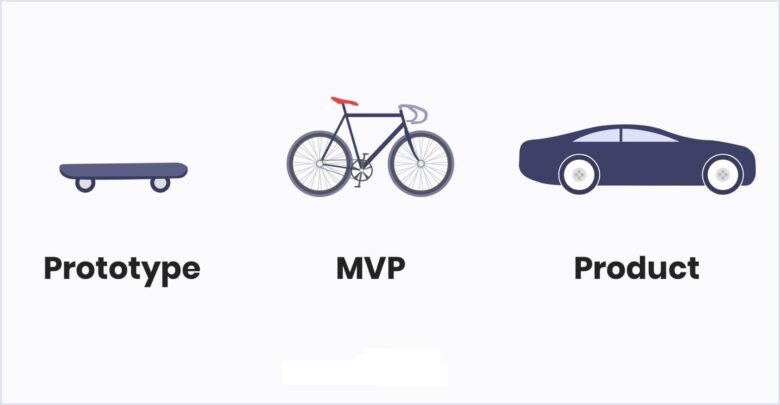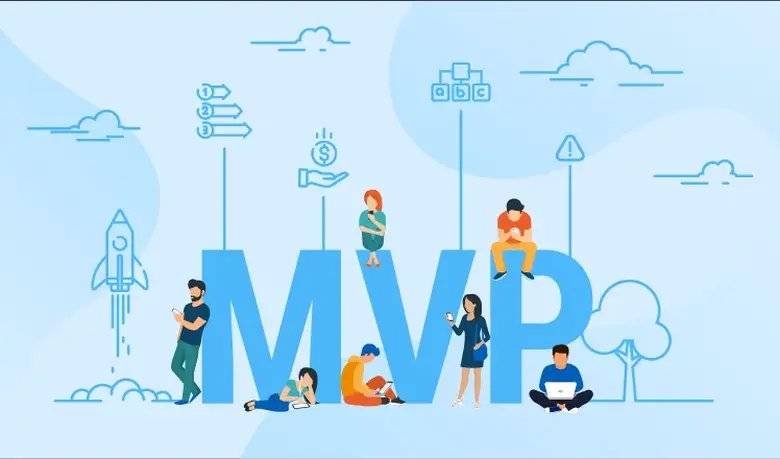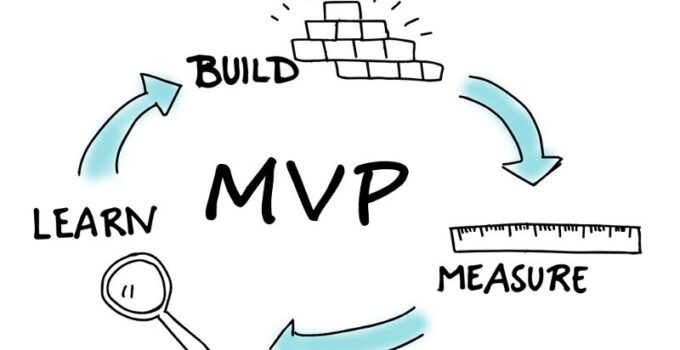Minimal Viable Product (MVP) is a test version of a product with a minimal set of features that brings value to the end user.
MVP development is a way to test hypotheses at minimal cost. Developers estimate the market demand, collect practical data, and track users’ reactions. Based on the information gathered, the team makes a decision to continue, adjust, or cancel work on the project.
Consider the example of the well-known application WhatsApp. Jan Koum and Brian Acton initially wanted to create a mobile phone book with the status of the contact: available, in a meeting, busy, at the gym, etc. When users specified a status, their contacts received a pop-up notification. Soon, statuses began to be used for communication. Then, the developers of the application released a new version with more features related to sending messages. Further fate of this app, you know.
Outsourcing for MVP development

Source: mvp.dev
For startups and businesses, it’s important to quickly get proof of the viability of the idea, attract investments and find a niche in the market. That’s why it’s recommended to outsource MVP development company such as Purrweb that shares the advantages of such way:
- Free up resources and focus on business development strategies.
It is necessary to reduce the load on the employees and get rid of routine, so you can react to customers’ feedback in time and solve difficulties in time.
- You don’t need to build a team from scratch.
Here you eliminate several problems at once. Firstly, you don’t need to look for IT specialists. You save the HR-specialist time, because it takes an average of 51-58 days to select them, while the MVP development takes 3 months. Secondly, you don’t need to organize the complicated process of internal communication between employees. It takes at least 3 weeks for the team to work well.
- Saves money.
With highly efficient processes, you cut your administrative costs by 30% on average.
- Avoid errors.
The development company already has experience in creating MVPs, so they will help you get the best product. They will share their experience and knowledge and protect you from typical mistakes. With the help of a professional team, you will be able to optimize and automate internal processes. You will also get information on how to work with the product and manage it.
Working with the outsourced team is time and effort on your part. You will set tasks, accept work, formulate product goals, define customer usage scenarios and set performance ratios. An outside contractor can also help you with the Terms of Reference and the product development roadmap.
How to build MVP correctly

Source: codica.com
Let’s consider the building of a house. Before you get a comfortable home with modern designer interiors and decor, you need a foundation, strong walls, and a roof. As the construction work progresses, you can make changes to the project to get the most comfortable space for your needs. And here it is important not to build the house of straw, as in the fairy tale about the three little pigs.
You need to understand that the MVP is a quality product, which will be the foundation for the development and testing of your project in the future.
Steps for MVP development
- Define the tasks that the product solves
What does the user need the product for? What customer problem does it solve? For example, it gives the possibility to book accommodation all over the world, order food from your favorite restaurant etc.
- Identify and analyze the Target Audience
Build a user profile based on gender, age, interests, income level, social status, behavior. Determine the approximate number of people interested in the product, based on the portrait. Use analytical tools such as Google Analytics, Facebook, Twitter and statistical data from publicly available sources.
- Identify competitors
In 19% of cases, the reason for the closure of the project/startup is crowding out by a competitor. Gather a database of potential companies with similar products, analyze their strengths and weaknesses.This analysis should include both direct and indirect competitors.
It is better to collect all the data in a single file. This information will also come in handy when planning your marketing strategy. Special analytical tools can help you: SimilarWeb, Ahrefs, Quantcast, AppAnnie, AppFlow and others.
- Do a SWOT analysis.

Source: wordstream.com
To do this, make a table of 4 blocks.
– strengths
– weaknesses
– opportunities
– threats
- Develop a customer journey map.
This is a detailed step-by-step plan of the potential customer’s actions when interacting with the product. This map should be adjusted after receiving feedback from the customer. The map becomes a blueprint for designing the application interface.
- Develop the functionality of the MVP.
You should define the basic functions, maybe just one, that solve the client’s problem and help to analyze the business idea.
- Define the development process.
The right management model is your key to success.
The following options are possible:
– Scrum
– Kanban
– Lean
– EP
- Conduct testing.

Source: einfochips.com
The product needs regular testing. This is usually A/B testing. The product is released after fixing technical bugs and testing within the team. And only after that the MVP will be seen by the first customers. You can use specialized websites, or your own social networks, blogs and email newsletters.
After collecting the feedback from customers, surveys you start to analyze the viability of the business model, to draw intermediate conclusions. Be adaptive, change your priorities depending on the needs of your audience. You can change the concept and focus of the project.
Major errors in MVP development
- Pursuit of perfection. MVP is an opportunity to give the user a basic idea, but it’s not a completely finished product. The aspiration to an ideal can lead to failure because the prototype is overloaded with functions.
- The flip side of perfection is a substandard product.
- Lack of interaction with the customer. You can’t get overly involved in development and not give importance to feedback.
- False expectations of the user. Talk honestly about your product. So that expectations do not diverge from reality.
MVP development team. Who are they?
- The project manager communicates with the customer, collects and processes requirements, sets tasks for each team member, monitors deadlines, coordinates and controls the progress of work, manages the project budget, prepares reports, and maintains technical documentation.
- The UI/UX designer creates the logic for MVP development, performs user and competitor analysis, plans the content screens, prepares the information architecture of the application, develops the user frames, design concepts and prototypes, and performs usability tests and A/B testing. The designer works in close conjunction with the developers. The speed of task completion by the developers depends on the right actions of the UI/UX designer.
- Developers (Back-end, Front-end) deal with the internal content of the system, server technologies – the database, architecture, program logic, and create a user interface.
- DTP specialist performs layout of web-sites, ensures correct and uniform display of the web-resources in all major browsers, splits the texts into separate pages, and compiles it with the illustrations. Typewriting templates for stationary monitors and mobile devices (based on ready-made psd-mockups).

Source: devteam.space
Minimum viable product is your helper in the startup world, allows:
- Test product hypotheses with real data.
- Reduce the risk of financial loss in case of a failed product launch.
- Gather a user base before launching the main product.




